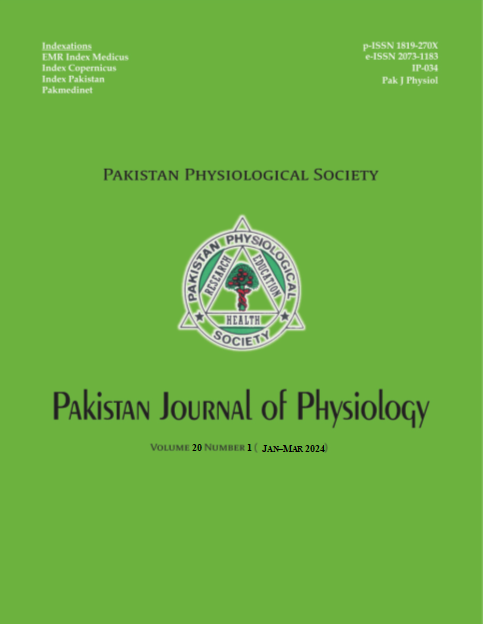PROTECTIVE EFFECTS OF SILYMARIN AND CHOLCALCIFEROL ON ISONIAZID INDUCED HEPATOTOXICITY IN MICE
DOI:
https://doi.org/10.69656/pjp.v20i1.1450Keywords:
Silymarin, Hepatotoxicity, Isoniazid, CholecalciferolAbstract
Background: Hepatotoxicity is the gravest concern associated with use of anti-tuberculous drugs. The objective of this study was to evaluate the individual and combined hepatoprotective effect of silymarin and cholecalciferol in isoniazid induced hepatotoxicity. Methods: This animal experimental study was conducted at the Department of Pharmacology & Therapeutics, and Multidisciplinary Research Laboratory, Islamic International Medical College, in collaboration with National Institute of Health, Islamabad, Pakistan. Fifty adult Balb-C mice were included in this study. They were distributed into 5 groups. Each group contained 10 mice. Group 1 was normal control, Group 2 disease control, and Group 3, 4, and 5 were experimental groups. Except Group 1, all other groups were given isoniazid (150 mg/Kg) and only Group 2 was not fed with any drugs. Group 3 received silymarin (50 mg/Kg dissolved in physiological saline) through intragastric gavage for 28 days. Group 4 was given Vitamin D (1,000 IU/Kg) for 28 days. Group 5 was given isoniazid (150 mg/Kg) along with silymarin and Vitamin D for 28 days. Serum ALT and bilirubin levels were estimated on day 0, 14, and 28. Results: As compared to Group 2, Group 3 to Group 5 showed a lower rise in serum ALT and bilirubin (p<0.001). Group 4 and 5 showed significantly reduced biochemical markers (ALT and bilirubin) (p=0.001). Conclusion: Silymarin and cholecalciferol effectively and synergistically ameliorate hepatotoxicity induced by isoniazid. Silymarin offers better hepatoprotection than cholecalciferol in isoniazid induced hepatotoxicity.
Pak J Physiol 2024;20(1):37-40
Downloads
References
Kurokawa T, Zheng YW, Ohkohchi N. Novel functions of platelets in the liver. J Gastroenterol Hepatol 2016;31(4):745–51.
Hasan R, Jabeen K, Mehraj V, Zafar F, Malik F, Hassan Q, et al. Trends in Mycobacterium tuberculosis resistance, Pakistan, 1990–2007. Int J Infect Dis 2009;13(6):e377–82.
Tariq S, Khan TS, Malik S, Anwar MS, Rashid A. Frequency of anti-tuberculous therapy-induced hepatotoxicity in patients and their outcome. J Ayub Med Coll Abbottabad 2009;21(4):50–2.
Dheda K, Barry CE 3rd, Maartens G. Tuberculosis. Lancet 2016;387(10024):1211–26.
Tahseen S, Khanzada FM, Baloch AQ, Abbas Q, Bhutto MM, Alizai AW, et al. Extrapulmonary tuberculosis in Pakistan –A nation-wide multicenter retrospective study. PloS One 2020;15(4):e0232134.
Cambau E, Viveiros M, Machado D, Raskine L, Ritter C, Tortoli E, et al. Revisiting susceptibility testing in MDR-TB by a standardized quantitative phenotypic assessment in a European multicentre study. J Antimicrob Chemother 2015;70:686–96.
Durand F, Bernuau J, Pessayre D, Samuel D, Belaiche J, Degott C, et al. Deleterious influence of pyrazinamide on the outcome of patients with fulminant or subfulminant liver failure during antituberculous treatment including isoniazid. Hepatology 1995;21(4):929–32.
Metushi IG, Cai P, Zhu X, Nakagawa T, Uetrecht JP. A fresh look at the mechanism of isoniazid?induced hepatotoxicity. Clin Pharmacol Ther 2011;89(6):911–4.
Holick MF, Chen TC. Vitamin D deficiency: a worldwide problem with health consequences. Am J Clin Nutr 2008;87(4):1080–6S.
Wang X, Li W, Zhang Y, Yang Y, Qin G. Association between vitamin D and non-alcoholic fatty liver disease/non-alcoholic steatohepatitis: results from a meta-analysis. Int J Clin Exp Med 2015;8(10):17221–34.
Nakano T, Cheng YF, Lai CY, Hsu LW, Chang YC, Deng JY, et al. Impact of artificial sunlight therapy on the progress of non-alcoholic fatty liver disease in rats. J Hepatol 2011;55(2):415–25.
Polyak SJ, Morishima C, Lohmann V, Pal S, Lee DY, Liu Y, et al, Identification of hepatoprotective flavonolignans from silymarin. Proc Natl Acad Sci USA 2010;107(13):5995–9.
Hasanain AFA, Zayed AAH, Mahdy RE, Nafee AMA. Cholecalciferol for prophylaxis against antituberculosis therapy-induced liver disorders among naïve patients with pulmonary tuberculosis: A randomized, comparative study. Int J Mycobacteriol 2017;6(2):149–55.
Arifin WN, Zahiruddin WM. Sample size calculation in animal studies using resource equation approach. Malays J Med Sci 2017;24(5):101–5.
Jahan S, Danish L, Khan M, Sandhu M, Abrar N, Siddiq R, et al. Comparative study of protective effect of silymarin and n-acetyl cysteine on isoniazid induced hepatotoxicity in mice. Iranian J Pharmacol Ther 2019;17:1–10.
Ilyas N, Sadiq M, Jehangir A. Hepatoprotective effect of garlic (Allium sativum) and milk thistle (silymarin) in isoniazid induced hepatotoxicity in rats. Biomedica 2011;27(2):166–70.
Gatera VA, Abdulah R, Musfiroh I, Judistiani RTD, Setiabudiawan B. Updates on the status of vitamin D as a risk factor for respiratory distress syndrome. Adv Pharmacol Sci 2018;2018:8494816.
Brewer CT, Kodali K, Wu J, Shaw TI, Peng J, Chen T. Toxicoproteomic profiling of hPXR transgenic mice treated with rifampicin and isoniazid. Cells 2020;9(7):1654.
Eminzade S, Uras F, Izzettin FV. Silymarin protects liver against toxic effects of anti-tuberculosis drugs in experimental animals. Nutr Metab 2008;5:18.
Wang YQ, Geng XP, Wang MW, Wang HQ, Zhang C, He X, et al. Vitamin D deficiency exacerbates hepatic oxidative stress and inflammation during acetaminophen-induced acute liver injury in mice. Int Immunopharmacol 2021;97:107716.
Luangchosiri C, Thakkinstian A, Chitphuk S, Stitchantrakul W, Petraksa S, Sobhonslidsuk A. A double-blinded randomized controlled trial of silymarin for the prevention of antituberculosis drug-induced liver injury. BMC Complement Altern Med 2015;15:334.
Reddy MK, Reddy AG, Kumar BK, Madhuri D, Boobalan G, Reddy MA. Protective effect of rutin in comparison to silymarin against induced hepatotoxicity in rats. Vet World 2017;10:74–80.
Downloads
Published
How to Cite
Issue
Section
License
Copyright (c) 2024 Rabia Iftikhar Malik, Akbar Waheed, Salma Salim, Fatima Muhammadi, Nimra Ijaz, Uzma Naeem

This work is licensed under a Creative Commons Attribution-NoDerivatives 4.0 International License.
The author(s) retain the copyrights and allow their publication in Pakistan Journal of Physiology, Pak J Physiol, PJP to be FREE for research and academic purposes. It can be downloaded and stored, printed, presented, projected, cited and quoted with full reference of, and acknowledgement to the author(s) and the PJP. The contents are published with an international CC-BY-ND-4.0 License.











